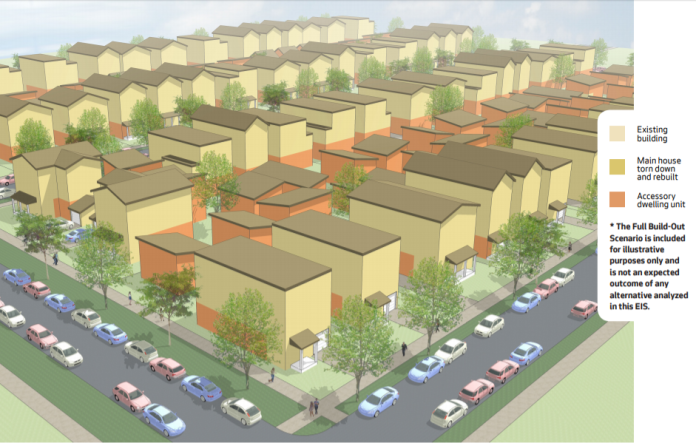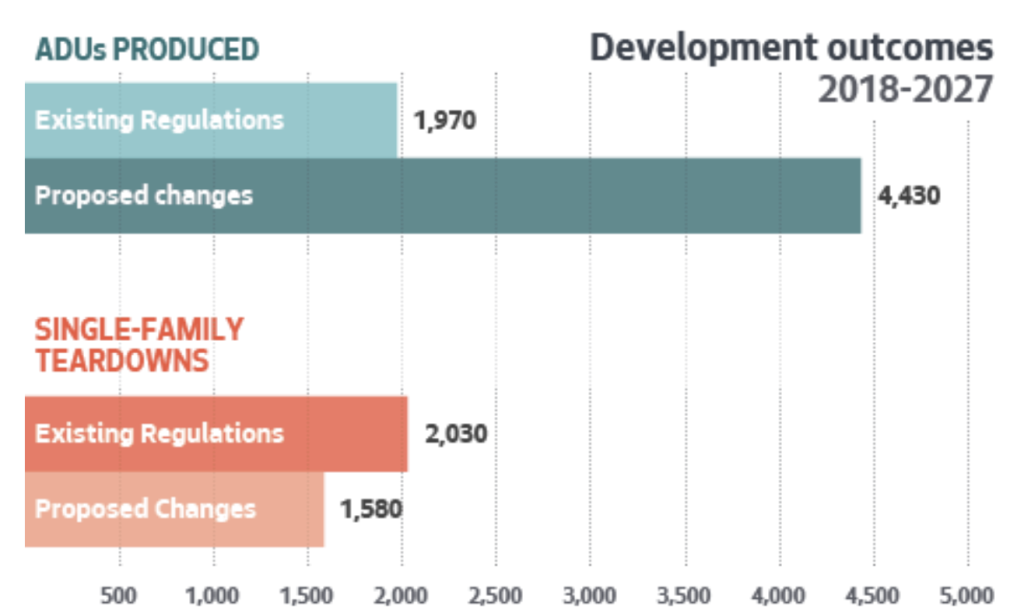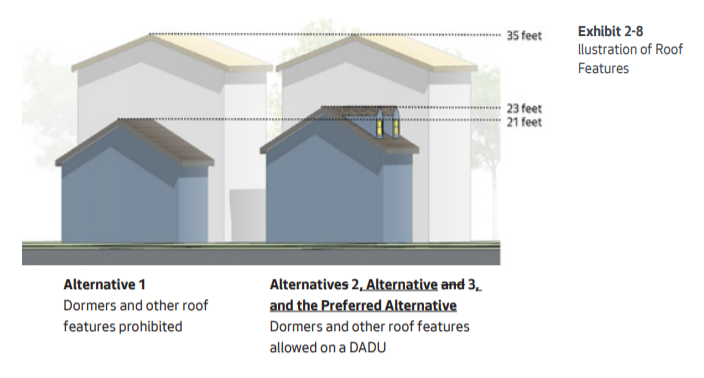
On Monday, the Seattle City Council unanimously (8-0 vote) adopted a land use reform bill, easing restrictions on building accessory dwelling units (ADUs) in single-family zones. The legislation is projected to promote development of another 2,460 new ADUs over a ten-year period. The changes brought forth by the legislation are far reaching, touching on topics related to owner-occupancy requirements and family size maximums to building heights for detached accessory dwelling units (DADUs or backyard cottages in common parlance).
Councilmember Mike O’Brien has championed the effort for five years while on the city council, pushing it ahead despite twists and turns from appeals and added studies. “It’s a lot of work that people have done for a relatively modest shift in what we predict will happen in our neighborhoods,” he said. “But I also think the reason why people have engaged in such a deep level is because there is a fundamental question about what we’re going to do in our single-family zones and what’s appropriate.”
O’Brien commended staff, colleagues, and community for their work in shaping the legislation and expressed optimism about opportunities that ADUs will provide to future residents. Mayor Jenny Durkan also commended the legislation as a step in the right direction, but said that more action is needed on the affordable housing front.
“Seattle is in the midst of an affordability and housing crisis,” Mayor Durkan said in a statement. “This crisis calls on each of us to act with urgency, using every tool available to increase housing options and make room for our neighbors as quickly as possible. Today, the Seattle City Council took an important step with the passage of this legislation, but there is more work to do.”

The city council took up Councilmember O’Brien’s base legislation proposal and made a variety of tweaks, generally in the direction of fewer barriers to ADUs. The following highlight where legislators landed on final regulatory changes:
- Up to two ADUs per lot. Property owners will be able to construct or convert space for up to two ADUs in all single-family zones, except the Residential Small Lot zone (only one is permitted in that zone). To achieve the maximum, property owners have two choices: either one attached and one detached ADU or two attached ADUs. A second ADU built as a detached ADU will require compliance with green building practices for either the detached ADU or new principal residence. Alternatively, a property owner could choose to commit to renting the second ADU as affordable housing for a minimum of 50 years at no more than 80% area median income to eligible households.
- Number of unrelated persons per lot increased. The ordinary maximum of eight unrelated persons allowed to live on a lot at any given time will continue to apply, except that the maximum will increase to 12 unrelated persons per lot if two ADUs are located on a lot.
- Owner-occupancy requirements eliminated. The existing owner-occupancy requirement will be fully removed. Existing requirements stipulate that the owner must live on the property at least six months per calendar year.
- Off-street parking requirements eliminated. ADUs will no longer be subject to minimum off-street parking requirements. However, all existing required parking spaces on a lot must be maintained in quantity.
- Size limitations increased. Detached ADUs are currently limited to 800 square feet, inclusive of storage and an attached garage, while attached ADUs are permitted up to 1,000 square feet. All ADUs will be allowed up to 1,000 square feet, exclusive of storage and any attached garage. Detached ADUs will be able to achieve an extra 35 square feet for bike storage.
- Minimum lot size reduced. Attached ADUs may be on any lot size, but detached ADUs will be authorized on lot at least 3,200 square feet in size where the current standard is on lots at least 4,000 square feet in size.
- Building height limits increased. Base height limits on detached ADUs range from 12 feet to 16 feet under current regulations, depending upon lot width. Additional height is allowed for butterfly, shed, and pitched roof designs above the base height, generally providing an extra three feet to seven feet in building height to work with. The new regulations will generally allow an extra two feet for the base height limits, so that lots with less than 30 feet in width permit detached ADUs up to 14 feet in height and lots greater than 50 feet in width permit detached ADUs up to 18 feet in height. On top of this, roof designs using green building strategies could benefit from a bonus two feet in height. Open railings up to four feet above the base height limit will be permitted to allow rooftop decks.
- Rear yard lot coverage increased. In addition to a basic maximum lot coverage standard of 35%, accessory structures are subject to a maximum 40% rear year lot coverage standard. Detached ADUs will be given more flexibility with a maximum of 60% rear lot coverage, provided that the rear yard lot coverage increase does not require removal of any exceptional tree or large trees with a diameter at breast height over two feet.
- FAR maximum imposed for McMansions. To ban the construction of McMansions and stem teardowns, a floor area ratio (FAR) cap will apply to single-family residential lots. A maximum of 0.5 FAR for all will apply to all structures, except on lots smaller than 5,000 square feet in size. In that case, property owners will be authorized up to 2,500 square feet of total floor area on the lot, inclusive of all structures. However, there are several exemptions: all ADU space, portions of structures built underground, and either other accessory structures up to 500 square feet in area or attached garages up to 250 square feet. Additions to pre-existing homes will also be exempt from the FAR cap as long as they do not exceed a 20% increase.

Other minor changes included in legislation require tree retention and installation when a new ADU is built, allowance of entrances to ADUs on any building face as long as the unit is at least 10 feet from a lot line, and architectural flexibility for minor projections like windows, dormers, chimneys, bay windows, and skylights.
In addition to regulatory changes, the legislation also spells out actions for several departments to carry out in response to ADU reform. These include:
- Encouraging the Seattle Department of Transportation to install bike parking in single-family residential areas.
- Requiring the Seattle Department of Finance and Administrative Services to report on the use of short-term vacation rentals in ADUs and provide recommendations on if additional regulations should be imposed on them, particularly if a significant number of ADUs are being used as short-term vacation rentals.
- Requiring the Seattle Department of Construction and Inspections (SDCI) to report annually to the Planning, Land Use, and Zoning Committee on ADU activity, with the first report due summer 2021 and final report in 2025. The report will need to look at a variety of factors, including location of ADUs, number of ADUs and their type, number of ADU permits issues, and dimensional details of ADUs. It will also need to report on the number of off-street parking spaces created and any parking-related impacts, including recommendations for any modifications, if warranted.
- Requiring SDCI to create an amnesty program for unpermitted existing ADUs.
- Requiring the Seattle Office of Housing to report on findings from a pilot program to allow low-income homeowners to create extra space for ADUs on their property and provide recommendations how the program could be expanded. The report is due in September 2020.
- Requiring SDCI, in collaboration with the Seattle Office of Planning and Community Development, to carry out a voluntary survey of ADU owners and occupants by mid-summer 2022.
Except for the FAR limitations, the legislation will come into force 30 days from signing by the mayor. FAR limitations will become effective in March.
If the ADU legislation is successful, Seattle should begin to see backyard cottages and mother-in-law apartments grow by over 400 units per year, a competitive number with peer cities.
Stephen is a professional urban planner in Puget Sound with a passion for sustainable, livable, and diverse cities. He is especially interested in how policies, regulations, and programs can promote positive outcomes for communities. With stints in great cities like Bellingham and Cork, Stephen currently lives in Seattle. He primarily covers land use and transportation issues and has been with The Urbanist since 2014.


